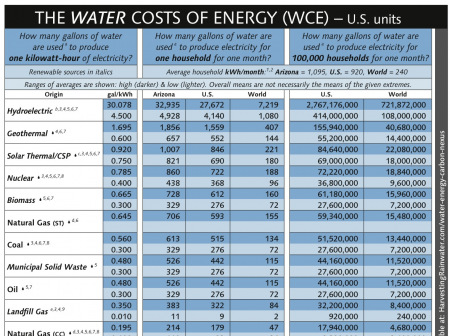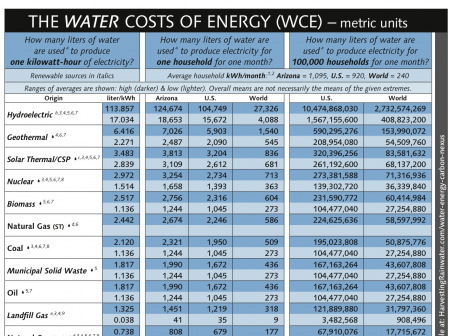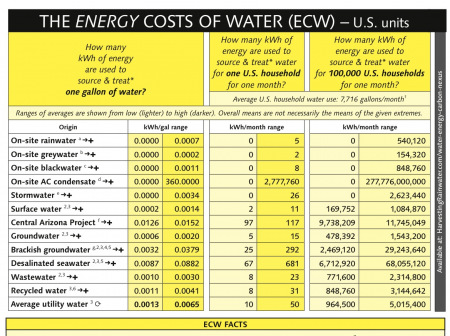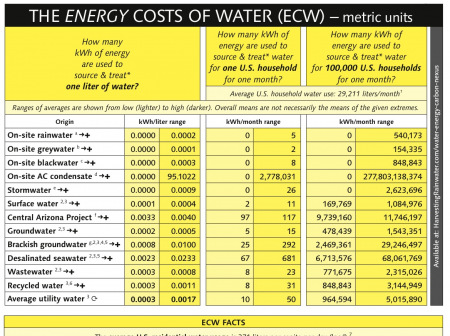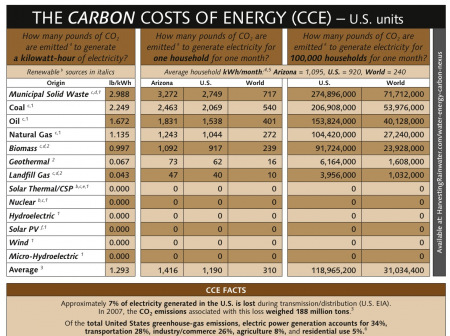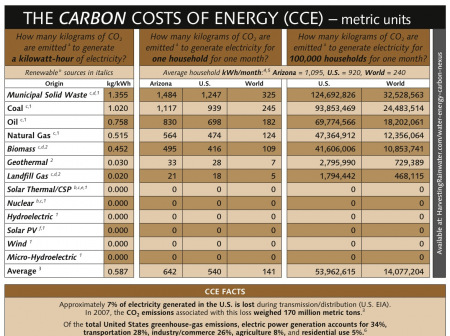Water-Energy-Carbon Nexus
This webpage is an extension of Appendix 9: Water-Energy-Carbon Nexus from Rainwater Harvesting for Drylands and Beyond, Volume 1, 2nd Edition. See that appendix for more.
Water Costs of Energy
How much water is expended in the generation of electricity from different sources? How much energy, and subsequently embedded water, do average Arizona, U.S., and global households use per month, depending on where their energy comes from? How about you and your community?
Take a look at our most-recent versions of the Water Costs of Energy charts. The main page of both the metric and U.S.-unit charts are visible in JPG format below. If you’d like to download their full PDF versions, look for the links under the thumbnails.
Download the full U.S.-unit Water Costs of Energy chart (including all notes and references) here.
Download the full metric-unit Water Costs of Energy chart (including all notes and references) here.
Please bear in mind that these resources are NOT definitive, as the watergy (water-energy nexus) question is a complex one, and the data available to us are not always consistent in terms of definitions, methods, units, or real-world circumstances surrounding the collection of these data. As much as possible we have added consistency and transparency to what we present, and we plan to update these resources periodically as we become aware of additional research. Questions and suggestions welcome, directed to admin@harvestingrainwater.com.
Water Costs of Electricity in Arizona
Click to download this project fact sheet from the Arizona Water Institute showing the findings of investigators Martin Pasqualetti and Scott Kelley. Findings include number of gallons of water required to produce a megawatt-hour of energy from nuclear power, coal, natural gas, biofuel, solar thermal, geothermal, and roof-top solar PV systems. Note: solar thermal energy production uses much more water than roof-top solar PV (or wind) systems do.
Water footprint calculators
www.waterfootprint.org
This site provides calculators and more for global, national, corporate, product, and individual/your water footprints.
National Geographic water footprint calculator
This is a general illustrated calculator for individuals.
Energy Costs of Water
The flip side of the water costs of energy? The energy costs of water: how much energy is required to source, treat, and distribute water to anywhere with indoor plumbing, and to deal with what goes back into the municipal system after it goes down our drains? Your water bill is only the beginning.
Take a look at our most-recent versions of the Energy Costs of Water charts. The main page of both the metric and U.S.-unit charts are visible in JPG format below. If you’d like to download their full PDF versions, look for the links under the thumbnails.
Download the full U.S.-unit Energy Costs of Water chart (including all notes and references) here.
Download the full metric-unit Energy Costs of Water chart (including all notes and references) here.
As above, please keep in mind that these resources are NOT definitive, as the watergy (water-energy nexus) question is a complex one, and the data available to us are not always consistent in terms of definitions, methods, units, or real-world circumstances surrounding the collection of these data. As much as possible we have added consistency and transparency to what we present, and we plan to update these resources periodically as we become aware of additional research. Questions and suggestions for new sources welcome, directed to admin@harvestingrainwater.com.
Carbon Costs of Energy
In addition to embedded water, the energy we consume also contains embedded carbon dioxide emissions. How many pounds of CO2 are emitted to generate one kilowatt-hour (kWh) of electricity from various sources? How about an average household’s monthly electricity supply? Or a community of 100,000 households?
Take a look at our most-recent versions of the Carbon Costs of Energy charts. The main page of both the metric and U.S.-unit charts are visible in JPG format below. If you’d like to download their full PDF versions, look for the links under the thumbnails.
Download the full U.S.-unit Carbon Costs of Energy chart (including all notes and references) here.
Download the full metric-unit Carbon Costs of Energy chart (including all notes and references) here.
See the new, full-color, revised editions of Brad’s award-winning books
– available a deep discount, direct from Brad:


